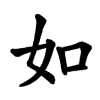Definify.com
Definition 2025
或
或
Translingual
| Stroke order | |||
|---|---|---|---|

| |||
Han character
或 (radical 62 戈+4, 8 strokes, cangjie input 戈口一 (IRM), four-corner 53100, composition ⿹戈⿱口一)
Usage notes
While 或 is both a traditional and simplified character (it was not simplified), it is simplified as a component of the character 國 → 国.
Derived characters
References
- KangXi: page 412, character 18
- Dai Kanwa Jiten: character 11563
- Dae Jaweon: page 754, character 17
- Hanyu Da Zidian: volume 2, page 1402, character 8
- Unihan data for U+6216
Chinese
|
simp. and trad. |
或 | |
|---|---|---|
Glyph origin
| Historical forms of the character 或
| |||
|---|---|---|---|
| Oracle bone script | Bronze inscriptions | Large seal script | Small seal script |
 |
 |
 |
 |
| Characters in the same phonetic series (或) (Zhengzhang, 2003) | |
|---|---|
| Old Chinese | |
| 幗 | *kʷɯːɡs, *kʷrɯːɡ |
| 慖 | *kʷɯːɡs, *kʷrɯːɡ |
| 簂 | *kʷɯːɡs |
| 蔮 | *kʷɯːɡs |
| 國 | *kʷɯːɡ |
| 或 | *ɡʷɯːɡ |
| 惑 | *ɡʷɯːɡ |
| 蜮 | *ɡʷɯːɡ, *ɢʷrɯɡ |
| 閾 | *qʰʷrɯɡ |
| 緎 | *qʰʷrɯɡ, *ɡʷrɯɡ |
| 淢 | *qʰʷrɯɡ, *ɡʷrɯɡ |
| 域 | *ɢʷrɯɡ |
| 罭 | *ɢʷrɯɡ |
| 棫 | *ɡʷrɯɡ |
| 琙 | *ɡʷrɯɡ |
| 魊 | *ɡʷrɯɡ |
| 馘 | *kʷrɯːɡ |
| 聝 | *kʷrɯːɡ |
| 膕 | *kʷrɯːɡ |
| 摑 | *kʷrɯːɡ |
| 漍 | *kʷrɯːɡ |
| 嘓 | *kʷrɯːɡ |
| 蟈 | *kʷrɯːɡ |
| 掝 | *qʰʷrɯːɡ |
| 彧 | *qʷrɯɡ |
| 稶 | *qʷɯɡ |
Ideogrammic compound (會意) : 戈 + 口 + 一, “territory”.
Borrowed for abstract meanings. The derivative 國 (OC *kʷɯːɡ) and 域 (OC *ɢʷrɯɡ) refer to the original word.
Note that 咸 is not derived from 或, and that the characters 口 and 一 are stacked in the opposite order in these characters. Both are ultimately from 戈 (“halberd, spear”).
Pronunciation 1
- Mandarin
- Cantonese (Jyutping): waak6
- Hakka (Sixian, PFS): fe̍t
- Min Nan (POJ): he̍k
- Wu (Wiktionary): hhoq (T5); hhueq (T5)
- Mandarin
- (Standard Chinese, Beijing)+
- Pinyin:
- Zhuyin: ㄏㄨㄛˋ
- Wade-Giles: ho4
- Gwoyeu Romatzyh: huoh
- IPA (key): /xu̯ɔ⁵¹/
-

- (Standard Chinese, Beijing)+
- Cantonese
- (Standard Cantonese, Guangzhou)+
- Jyutping: waak6
- Yale: waahk
- Cantonese Pinyin: waak9
- IPA (key): /wɑːk̚²/
- (Standard Cantonese, Guangzhou)+
- Hakka
- (Sixian, incl. Miaoli and Meinong)
- Pha̍k-fa-sṳ: fe̍t
- Hakka Romanization System: fed
- Hagfa Pinyim: fed6
- IPA: /fet̚⁵/
- (Sixian, incl. Miaoli and Meinong)
- Min Nan
- (Hokkien)
- Pe̍h-ōe-jī: he̍k
- Tâi-lô: hi̍k
- Phofsit Daibuun: hek
- IPA (Xiamen): /hiɪk̚⁴/
- IPA (Quanzhou): /hiɪk̚²⁴/
- IPA (Zhangzhou): /hiɪk̚¹²¹/
- IPA (Taipei): /hiɪk̚⁴/
- IPA (Kaohsiung): /hiɪk̚⁴/
- (Hokkien)
- Wu
- (Shanghainese)
- Wiktionary: hhoq (T5); hhueq (T5)
- IPA (key): /ɦʊʔ¹²/, /ɦɯə̯ʔ¹²/
- (Shanghainese)
- Dialectal data▼
| Variety | Location | 或 |
|---|---|---|
| Mandarin | Beijing | /xuo⁵¹/ |
| Harbin |
/xuei²¹³/ /xuo⁵³/ |
|
| Tianjin | /xɤ⁵³/ | |
| Jinan | /xuei⁴²/ | |
| Qingdao |
/xuə⁴²/ /xue⁴²/ |
|
| Zhengzhou | /xuai⁴²/ | |
| Xi'an | /xuei²⁴/ | |
| Xining | /xuɨ²⁴/ | |
| Yinchuan | /xuə¹³/ | |
| Lanzhou | /xuə¹³/ | |
| Ürümqi | /xuɤ²¹³/ | |
| Wuhan | /xuɤ²¹³/ | |
| Chengdu | /xue³¹/ | |
| Guiyang | /xuɛ²¹/ | |
| Kunming | /xo³¹/ | |
| Nanjing | /xueʔ⁵/ | |
| Hefei | /xuɐʔ⁵/ | |
| Jin | Taiyuan | /xuəʔ²/ |
| Pingyao | /xuʌʔ⁵³/ | |
| Hohhot | /xuaʔ⁴³/ | |
| Wu | Shanghai | /ɦoʔ¹/ |
| Suzhou | /ɦuəʔ³/ | |
| Hangzhou | /ɦoʔ²/ | |
| Wenzhou | /va²¹³/ | |
| Hui | Shexian | /xuɛʔ²¹/ |
| Tunxi | /xo⁵/ | |
| Xiang | Changsha | /xo²⁴/ |
| Xiangtan | /ho²⁴/ | |
| Gan | Nanchang | /fɛʔ⁵/ |
| Hakka | Meixian | /fet̚⁵/ |
| Taoyuan | /fet̚⁵⁵/ | |
| Cantonese | Guangzhou | /wak̚²/ |
| Nanning | /wak̚²²/ | |
| Hong Kong | /wak̚²/ | |
| Min | Xiamen (Min Nan) | /hik̚⁵/ |
| Fuzhou (Min Dong) | /høyʔ⁵/ | |
| Jian'ou (Min Bei) | /xo²⁴/ | |
| Shantou (Min Nan) | /hok̚⁵/ | |
| Haikou (Min Nan) | /hok̚³/ |
| Rime | |
|---|---|
| Character | 或 |
| Reading # | 1/1 |
| Initial (聲) | 匣 (33) |
| Final (韻) | 德 (132) |
| Tone (調) | Checked (Ø) |
| Openness (開合) | Closed |
| Division (等) | I |
| Fanqie | 胡國切 |
| Reconstructions | |
| Zhengzhang Shangfang |
/ɦwək̚/ |
| Pan Wuyun |
/ɦʷək̚/ |
| Shao Rongfen |
/ɣuək̚/ |
| Edwin Pulleyblank |
/ɦwək̚/ |
| Li Rong |
/ɣuək̚/ |
| Wang Li |
/ɣuək̚/ |
| Bernard Karlgren |
/ɣwək̚/ |
| Expected Mandarin Reflex |
huó |
| Baxter-Sagart system 1.1 (2014) | |
|---|---|
| Character | 或 |
| Reading # | 1/2 |
| Modern Beijing (Pinyin) |
huò |
| Middle Chinese |
‹ hwok › |
| Old Chinese |
/*[ɢ]ʷˤək/ |
| English | some; or |
Notes for Old Chinese notations in the Baxter-Sagart system: * Parentheses "()" indicate uncertain presence; | |
| Zhengzhang system (2003) | |
|---|---|
| Character | 或 |
| Reading # | 1/1 |
| No. | 5548 |
| Phonetic component |
或 |
| Rime group |
職 |
| Rime subdivision |
0 |
| Corresponding MC rime |
或 |
| Old Chinese |
/*ɡʷɯːɡ/ |
Definitions
或
- or, either ... or
- perhaps, maybe
- occasionally, sometimes
- †someone, some people, something
-
- 齊人伐燕,勝之。宣王問曰:「或謂寡人勿取,或謂寡人取之」。 [Classical Chinese, trad.]
- 齐人伐燕,胜之。宣王问曰:“或谓寡人勿取,或谓寡人取之”。 [Classical Chinese, simp.]
- Qí rén fá yàn, shèng zhī. Xuān wáng wèn yuē: "huò wèi guǎrén wù qǔ, huò wèi guǎrén qǔ zhī". [Pinyin]
- Qi attacked Yan, conquering it. King Xuan said: "Some people tell me not to take it [Yan] for myself; some tell me to take it".
-
Pronunciation 2
- Mandarin
- (Standard Chinese, Beijing)+
- Pinyin:
- Zhuyin: ㄩˋ
- Wade-Giles: yü4
- Gwoyeu Romatzyh: yiw
- IPA (key): /y⁵¹/
-

- (Standard Chinese, Beijing)+
- Cantonese
- (Standard Cantonese, Guangzhou)+
- Jyutping: wik6
- Yale: wihk
- Cantonese Pinyin: wik9
- IPA (key): /wɪk̚²/
- (Standard Cantonese, Guangzhou)+
| Baxter-Sagart system 1.1 (2014) | |
|---|---|
| Character | 或 |
| Reading # | 2/2 |
| Modern Beijing (Pinyin) |
yù |
| Middle Chinese |
‹ hwik › |
| Old Chinese |
/*[ɢ]ʷrək/ |
| English | territory |
Notes for Old Chinese notations in the Baxter-Sagart system: * Parentheses "()" indicate uncertain presence; | |
Definitions
或
Compounds
Japanese
Kanji
(“Jinmeiyō” kanji used for names)
- This term needs a translation to English. Please help out and add a translation, then remove the text
{{rfdef}}.
Readings
Korean
Hanja
或 • (hok) (hangeul 혹, revised hok, McCune-Reischauer hok, Yale hok)
- This term needs a translation to English. Please help out and add a translation, then remove the text
{{rfdef}}.
Vietnamese
Han character
或 (hoặc, hoắc)
- This term needs a translation to English. Please help out and add a translation, then remove the text
{{rfdef}}.